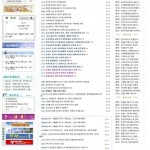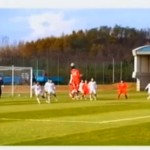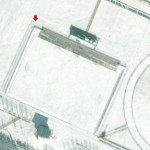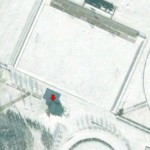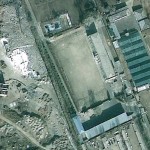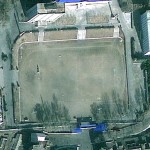According to Lankov:
2010 was a hard and dangerous year in Korea. Alas, 2011 might become even worse.
At first glance, this statement might appear excessively pessimistic. After all, in the last weeks the tensions on the Korean Peninsula were decreasing, North Korea suggested negotiations, and South Korea also said that talks might be a good idea.
However, the appearances are misleading. If one has a better look at the recent crisis, as well as at the current mood in Seoul and Pyongyang, there is little ground for optimism. It seems that both North Korean strategic calculations and South Korean assumptions about ways to handle its uneasy neighbor will bring the crisis back – and with a vengeance.
What we have seen throughout the last year was another exercise in the habitual North Korean brinkmanship – yet another attempt to apply tactics which have been used many times and usually with great success.
When North Korean strategists want to squeeze some aid or political concessions from other side, they follow a simple but efficient routine. First, Pyongyang manufactures a crisis, and does everything to drive tensions high. The missiles are launched, islands are shelled or nukes are tested, while the usual verbal bellicosity of the North Korean media reaches almost comical heights. Sooner or later both the “target audience” and international community begin to feel uneasy, and when this point is reached Pyongyang suggests negotiations. Its neighbors and adversaries alike feel relief and start talks, which usually end with Pyongyang getting what it wants – in exchange for restoring the status quo.
In the past, this tactic has worked well (for example, this is how in 2007 North Koreans managed to push the George W Bush administration to switch to a soft line and resume aid). However, this time things are different. So far, North Korea is not getting what it wants.
But what does the North want to achieve with this seemingly dangerous (but actually very calculated) military/political theater? As usually is the case with Pyongyang’s foreign policy, it is about money. In 2008 South Korea and United States dramatically reduced the amount of unilateral and unconditional aid to the North.
It had to turn to China instead. China obliged, and it seems that the North Korean economy – while still very poor by current East Asian standards – is in better shape than at any time since the early 1990s (albeit this modest recovery seems to be, first and foremost, brought about by domestic transformation rather than by Chinese aid). However, this made North Korean leaders excessively dependent on China, whom they do not like and whom they do not trust (this seems to be a mutual feeling).
So, they want the US and South Korean aid back. First, it will increase the size of the entire aid pie, controlled and distributed by the regime. Second, it will provide Pyongyang with ample opportunities to distance itself from dangerous China, and acquire a number of sponsors whose contradictions can be used to North Korea’s advantage. The North Korean diplomats are very good at this game, which they learned in the 1960s when they exploited the Sino-Soviet schism with remarkable success.
The North decided that this was a time to exercise pressure on both Seoul and Washington (actually, this is what it has been doing since 2008). It is not often noticed that North Korea actually conducts two separate, if related, blackmail programs – one aimed at the US and another aimed at South Korea. The ways of exercising pressure should be different, because the concerns of these two countries are dissimilar.
In the case of South Korea, the North decided to take advantage of Seoul’s dependence on the international markets. Foreign investors and trade partners of South Korean firms are not going to be amused by the newspaper headlines which talk a war “which is going to erupt on the Korean Peninsula”.
These tensions are likely to have a negative impact on the South Korean economy, making the South Korean voter worse off. On top of that, the average South Korean voter does not usually care too much about North Korea, but still expects its government to be capable at handling the North, in order to avoid major confrontations. Therefore, the North Korean leadership expects that sooner or later South Korean voters will penalize an excessively stubborn government by supporting the opposition.
To the US, the North’s selling point is its ability to proliferate. Since for the Americans the major (almost only) reason they care about North Korea is its potential for nuclear and missile proliferation, the North Korean regime demonstrated to Washington that even without aid and in spite of the international sanctions, North Korean engineers and scientists managed to make considerable progress in areas of military significance.
In mid-November, just before the shelling of Yeonpyeong Island, a group of American nuclear scientists led by Dr Siegfried Hecker from Stanford, was shown a state-of-the-art uranium-enrichment facility whose scale and sophistication exceeded what the US experts believed to be possible. This is a major step towards a full-scale military uranium program, which is, incidentally, more difficult to control than the old plutonium program.
Now, after a few months of tension building, the North Koreans decided to test the ground and check whether the adversaries (and potential donors) are ready to give in. Frankly, Pyongyang’s decision seems to be surprising, since the answer is obvious: neither Washington nor Seoul is ready to make concessions.
Why didn’t the old tactics succeed this time? In short, because the attitudes in both Washington and Seoul changed in recent years.
Talking about the US side, the main reason why Washington was in past willing to give concessions and unilateral aid, was the once widespread (albeit unfounded and naïve) belief that this was a way to facilitate the denuclearization of North Korea. It was assumed that Pyongyang could be persuaded/bribed/pressed into surrendering its nuclear program. This belief evaporated in 2008, after the second nuclear test.
American policymakers have finally realized that North Korea is not going to surrender its nukes under any circumstances. North Korean leaders are ready to talk about arms control, not about disarmament. In other words, North Korean leaders hope to get paid (generously) for freezing their nuclear program while still keeping the existent nuclear devices. The US is not ready to discuss this yet.
With South Korea, the situation is more complicated. The Lee Myung-bak government was in favor of a hard line from the very beginning. After the Cheonan sinking and Yeonpyeong shelling, the South Korean public, usually cautious when it comes to matters of peace and war, switched to support of the hard line.
In a poll in late November, some 80% of participants said they were in favor of a massive military retaliation in the case of the next North Korean attack (and a considerable minority even said that they did not mind a war). This unusual bellicosity of the public, reinforced by the even harder position of the military, puts additional pressure on the government.
Paradoxically, the events (or rather non-events) of early December contributed towards Seoul’s shift to a hard line. Then, soon after the Yeonpyeong shelling of November 23, the South Korean military staged large drills in the disputed waters near the North Korean coast. Before the exercises, the North Koreans threatened a mighty counterstrike, but when Seoul decided to go ahead on December 20, nothing happened.
North Korea’s decision not to execute its threats was seen as a sign of weakness. A triumphant South Korean official said in a private conversation: “They are with their tail between their legs now. This is what we should have done from the very beginning.”
Therefore, the dominant view in Seoul now is that if North Korean leaders know that their new strikes will be met with a mighty response, Pyongyang will not dare to stage another attack. So, Seoul politicians believe that harshness is the best option, since North Korean leaders will surely duck a fight.
This seems to be an illusion – and, perhaps, a dangerous one. Like it or not, there is no valid reason why Pyongyang strategists should be afraid of a Southern counterstrike. It is true that North Korea does not want a full-scale war, but due to the peculiarities of its political system North Korea can sustain a minor military confrontation far more easily than its southern counterpart – or, to be more precise, in the case of such a confrontation the domestic consequences for the North Korean government will be far less serious.
Needless to say, even if a South Korean counterstrike kills many hundreds of North Korean soldiers or sailors, the leaders will not feel too sorry of them (and children of the leaders do not serve in the North Korean military). The loss of a few pieces of rusty military equipment of 1960s vintage will not upset them too much, either.
It is sometimes stated that an efficient counterstrike will at least lead to a loss of face for the North Korean leadership, and that fear of such humiliation could serve as a deterrent against future attacks. Unfortunately this seems to be wishful thinking as well. The North Korean government is in full control of the media, so such a defeat will remain unknown to almost everyone outside the military elite.
If this is the case, why did the North avoid a fight in December, after so many threats and bellicose statements? Because there is no reason why it should agree to fight at the time and place chosen by its adversaries, when these adversaries were ready to strike back. It makes much more sense to wait for a while and then deliver a sudden and powerful strike when the North Korean political leadership decides that the time is ripe.
It seems that we are not going to wait for long. Recent events leave little doubt that the North Korean charm offensive will be ignored by Seoul (and, perhaps, by Washington as well, even though signals are slightly mixed). The first sign of this position became visible on January 6 when the US and South Korea rejected North Korea’s call for unconditional talks with South Korea as “insincere” and repeated their usual set of demands, which are, alas, clearly unacceptable for the North Koreans.
The North Korean leaders will probably do what they did before in similar situations: they will stage a provocation or two in order to increase pressure on the stubborn Americans and South Koreans, in hope that sooner or later they will give in. After all, contrary to what Seoul wants to believe, the associated political risks for the North Korean elite are small and rewards in case of eventual success are significant.
This coming round of military/diplomatic might be more dangerous than usual, largely because of Seoul’s newly acquired belief in the power of counterstrikes. Now it seems likely that in case of another North Korean strike the South will retaliate mightily. This counterstrike is likely to trigger a counter-counterstrike, and there is even a probability (albeit very minor) that such an exchange will escalate into a real war or at least some intense fighting.
Far more likely, though, is that the situation will remain under control. In this case, the excessive reaction by the South Koreans is likely to amplify the message their North Korean adversaries want to deliver.
North Korean strategists want to damage the South Korean economy as well as create domestic tension, which will eventually turn the South Korean public against the current South Korean government and its North Korean policy. However, if such an exchange of fire happens we can be certain that the international media will not be merely writing about a “war that is about to start in Korea” but rather will declare that a “war started in Korea”. The impact of such reports on the world markets and, eventually, on the South Korean economy is easy to predict.
The South Korean government should not be misled by the current bellicose mood of the voters. This mood is not likely survive a major confrontation, and once the situation becomes really tough, the same people who now cry for revenge are likely to start blaming the government for its inability to maintain a stable and secure situation on the peninsula.
Alas, not much can be done now. The North is likely to follow the usual line of a professional (and usually successful) blackmailer: since pressure has not worked, even greater pressure should be applied. The South, confident in the power of deterrence, is likely to over-react, thus further aggravating the situation and increasing the scale of the next crisis.
Well, it seems that the year 2011 will not be especially tranquil in Korea. And the subsequent few years might be even worse.
Read the full story here:
Push could soon turn to shove
Asia Times
Andrei Lankov
1/12/2011

